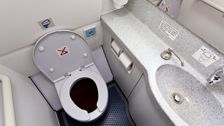
With the holidays fast approaching, many people are gearing up to fly ― some for the first time since the onset of the COVID-19 pandemic.
The risk of COVID exposure during air travel is considered relatively low, thanks to mask requirements, HEPA filtration systems, enhanced sanitation measures and the fact that passengers face the same direction and tend to sit quietly rather than shout or sing.
Still, the idea of spending hours in a metal tube with dozens ― if not hundreds ― of strangers understandably might not feel super-appealing. Being forced to share a small number of tiny bathrooms with them is even less so.
Thankfully, there are ways to minimize the spread of germs in the lavatory. Below, health and travel experts break down the most hygienic way to use the bathroom on a plane.
Disinfect surfaces.
“As an infection prevention specialist and someone who travels a lot, I have a routine when I fly,” said Michelle Barron, the senior medical director of infection prevention and control at UCHealth in Colorado. “When I sit down in my seat, I use a disinfecting wipe to wipe down the armrests, tray table and anything else that someone may have touched. Then I use hand sanitizer to clean my hands. The same routine works for a bathroom.”
Barron advised using disinfectant wipes on any lavatory door handles, lids and sinks before touching them.
Philip M. Tierno, a professor of microbiology and pathology at New York University’s Grossman School of Medicine, noted that although skin is a natural barrier to germs, he suggests traveling with a small tube of disinfecting spray for areas like the airplane bathroom.
“I would use Lysol spray on the seat before sitting on it,” Tierno said, then wait about a minute and wipe it off with a paper towel or face tissue. “The friction caused by the rubbing process as you wipe helps remove most debris there as well as many germs.”
Touch as little as possible.
Make sure you have a barrier between your bare hands and any surfaces you have to touch.
“The restroom likely holds a higher number of germs, and it is used by more people,” Barron said. “So it is important to limit contact with surfaces and use a disposable item like a paper towel to touch any door handles, toilet lids or handles, sinks, etc.”
Jagdish Khubchandani, a professor of public health at New Mexico State University, advised putting tissues on the toilet seat or paper seat covers if they’re available. Dispose of them when you’re finished.
“This helps maintain hygiene and saves others who follow a lot of hassle,” Khubchandani said. “Open the door with the tissue paper or wipes when exiting the lavatory. Put these tissue papers in trash.”
Consider not using the toilet paper to wipe.
“My biggest airplane bathroom hack is using the airplane tissues instead of the toilet paper,” said Brenda Orelus, a flight attendant and founder of Krew Konnect.
Earlier this year, Orelus posted this bathroom hack in an Instagram reel in which she explained that toilet paper is generally more exposed to liquids because it is usually located at a lower level.
“The tissue paper is typically located at eye level on commercial aircrafts,” Orelus told HuffPost. “Significantly increasing the likelihood that any liquid splashed on it is in fact just water.”
Close the lid before flushing.
We know that infectious microbes can spread through “toilet plumes” ― the dispersal of particles caused by flushing a toilet. These toilet aerosols can be vectors for diseases, including COVID-19.
There’s a simple way to help combat this.
“You can close the toilet’s lid before flushing to avoid spreading germs into the air during the flush cycle,” Barron said.
Jaromir Chalabala / EyeEm via Getty Images
Practicing good health hygiene on a plane will also keep your bathroom trips as clean as possible.
Wear shoes.
“On long duration flights, I have noticed people ― often, kids ― walk barefoot towards or into the bathroom,” Khubchandani said. “This is a very unhygienic tendency with potential for infection if someone has skin cuts and injuries on their foot. Also, you stay with the germs on your skin from the restroom for the entire flight unless you wash feet, which doesn’t happen much.”
He also suggested rolling your hems at the bottom if you’re wearing sweatpants or other long, loose garments to avoid droplets of urine, bits of tissue or other waste from getting on your clothes.
“Everything from the waist down is in an area where turbulence can lead to poor aim,” Orelus noted. “So no, it’s unlikely the liquid on the floor is water.”
Sanitize your hands.
Washing your hands thoroughly and frequently with soap and water is an important way to prevent the spread of germs. However, studies have suggested airplane lavatory water can be quite poor in quality.
“The reservoir of water in the bathroom tank can be grossly contaminated,” Tierno said. “As such, I would use 62% alcoholic gel to sanitize your hands rather than using the bathroom sink water.”
Avoid touching your face or mouth in the bathroom before cleaning your hands. The same goes for other steps of your travel journey.
“I’d also recommend keeping hand sanitizer nearby to use before and after eating or touching your face,” Tierno said.
Clean up after yourself.
“While going to the restroom, be considerate about others who may follow,” Khubchandani said. “We often don’t think about this or assume someone else will clean. This is disrespectful to other passengers and flight attendants if they have to clean up for us. So, flush as you go, dispose of trash in cans designated for waste, wipe the sink area and clean the toilet bowl if pieces of tissue or urine are spread around.”
He also advised using a different lavatory and notifying the flight attendant if you enter a bathroom and find previous passengers have left an overwhelming mess.
Take COVID and other health precautions.
Beyond the small steps you can take during your time in the bathroom, you can promote health and hygiene during air travel by following the guidance from experts: Wear your mask correctly, don’t fly if you’re feeling sick and make sure you’re up to date on your immunizations.
“Of course, we’re all wearing masks on airplanes now, which helps keep everyone safer, but the most important thing I recommend to everyone is to get the COVID-19 and influenza vaccines,” Barron said. “We’re expecting a more severe flu season this year, so get your flu shot now. I also recommend getting a booster shot of the COVID-19 vaccine if you meet the CDC’s criteria.”
Source link
CHECK OUT: Top Travel Destinations
READ MORE: Travel News



